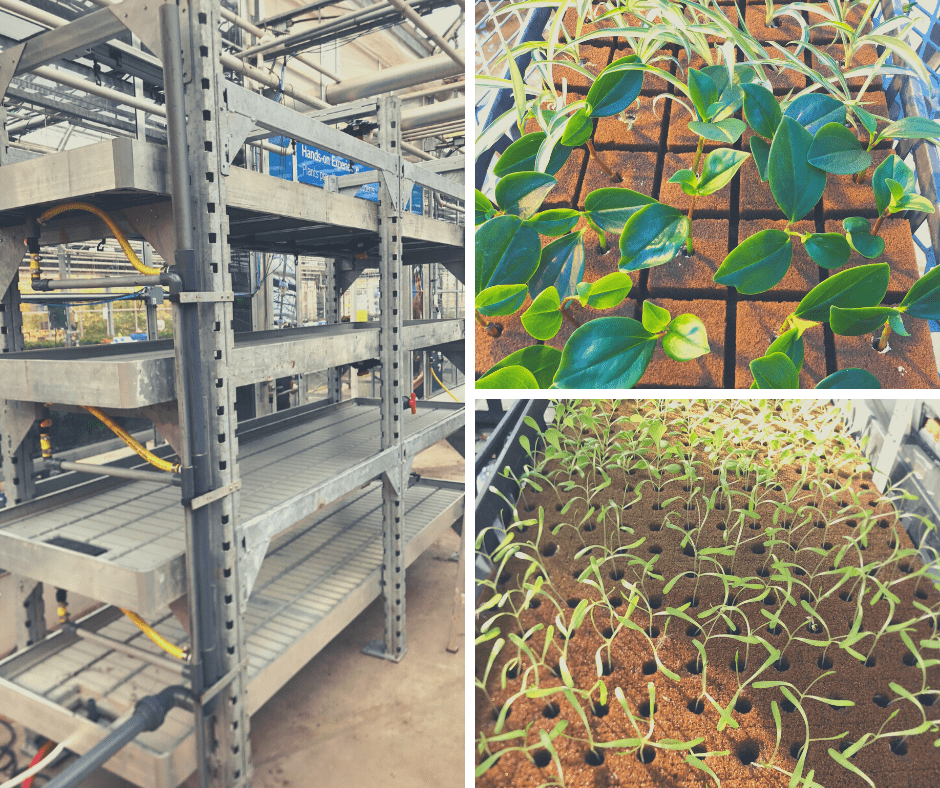
Challenge: How can we make a vertical growing system more efficient? Solution: Developed, tested new racking system/design Impact: New design reduces water usage, increases grower yield and profitability
For more than 50 years, Beamsville, Ont.’s Zwart Systems has been designing and manufacturing custom horticultural technology solutions for the greenhouse industry across North America.
With the aim of expanding its product line to offer a lower-cost growing option for the micro greens, cannabis and vegetable industry, the company designed a vertical growing system and partnered with the Greenhouse Technology Network‘s Horticultural & Environmental Sciences Innovation Centre (HESIC) at Niagara College for research and validation of the system engineering and efficacy.
In an effort to grow more on the same footprint, the role of vertical farming is gaining in popularity. Vertical growing can take many forms, from trellising cucumbers to growing lettuce in PVC pipes, says Felix Pozojevic, a second-year student in NC’s Greenhouse Technician program and a research assistant for this HESIC project.
“Vertical growing allows for farmers to use other mediums for plants to grow in. This can include spun volcanic rock (rockwool), coconut husks (coir), or even no substrate at all (aeroponics),” explains Pozojevic. “These growing alternatives are reactions to changing environmental conditions, lack of land access, increased food demands, and increased pressure for low food prices.”
Currently, the market believes that to grow floating lettuce requires 6″ to 12″ of continuously moving water. This is at great expense to the grower from a number of standpoints, water usage is chiefly among them. Other factors include the cost of the system infrastructure to achieve this water depth, as well as difficulties managing the waste water.
Through the applied research project, the goal was to test the multi-tiered growing system for greenhouse application using various crops, in hopes the Zwart Systems growing rack could bring a new option to the market for floating lettuce growth, and other crops in a water depth less than the current market thinking.
Zwart Systems’ product has four levels, utilizing the bottom level for ebb and flood production – a technique to deliver water and nutrients to plants – while the remaining three levels are equipped with misting nozzles, ideal for seed germination or cutting propagation. The goal is to conserve water and space, as prices for both resources continue to soar for greenhouse operators.
“Vertical growing allows for farmers to use other mediums for plants to grow in. These growing alternatives are reactions to changing environmental conditions, lack of land access, increased food demands, and increased pressure for low food prices.”
~ Felix Pozojevic, research assistant, AETIC
Some difficulties with ebb and flow, notes Pozojevic, such as expensive initial cost, (although labour savings quickly cover the investment), and water borne pathogens and diseases are easily spready throughout the entire crop through recirculated water. This means if water is not frequently tested, and diseased plants are not quickly removed, plants can contaminate each other very quickly.
The research team grew two main varieties of lettuce from seed, and propagated cuttings from peperomia (Peperomia sp) little leaf jade (Crassula ovata), monstera (Monstera adansonii), spider plant (Chlorophytum comosum), English ivy (Hedera helix), and German Ivy (Delairea odorata). All of these plants were grown with corresponding controls, all located at the greenhouse at Niagara College’s Daniel J. Patterson campus in Niagara-on-the-Lake.
Crop wet weight at harvest and dry weight were measured, as well as crop stretch at the end of the crop growth cycle before harvest.
Research reveals the multi-level growing system proves to be a successful design for lettuce seed germination and tropical plant cutting propagation. With structural and process changes, the ebb and flow bottom table has the potential to produce marketable lettuce in a recycling water system, using comparatively lower water levels than traditional ebb and flow or deep-water culture methods.
For Pozojevic, who is hoping to pursue a career in research, this was an “amazing” introduction project. “This project was instrumental in my understanding of how research operates, how to formulate and perform trials, record data, present my data in a professional manner for clients, and has increased my personal confidence in my growing abilities.”
Niagara College’s HESIC team works with private and public sector partners to develop innovative solutions to address today’s challenges in agriculture, local and sustainable food production, plant growth, horticulture practices, greenhouse operations, aquaponics and environmental management.
This project is funded in part by the Government of Canada through the Federal Economic Development Agency for Southern Ontario.
The HESIC growing trial also received funding from the Ontario Centre of Innovation (OCI) through their College Voucher for Technology Adoption (CVTA) program and the NC-led Greenhouse Technology Network (GTN).
Visit Niagara College’s Horticultural & Environmental Sciences Innovation Centre page to learn more about their resources and capabilities.






